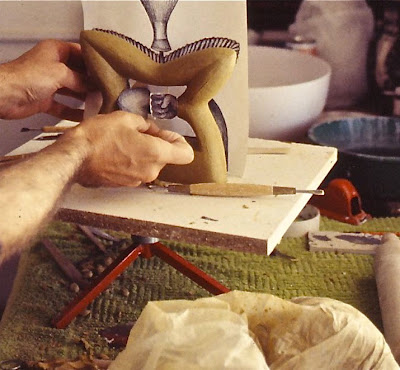.JPG) |
| Dija Nwana (Night Howler) Hand-built Porcelain Sculpture, Size 220mm height X 175mm width. Black Amaco vitrified.Collection Carl Landsberg. |
Literary Sources. The literary sources were , The famished road, by Ben Okri and Indaba my children by Vusamazulu Credo Mutwa and numerous books on African mythology, narratives and legends (details at the bottom) Both these two authors refer to spirits that invade humans and cause evil in the land. Ben Okri describes his main character's encounter with the spirit world as follows and I quote,
'I went back to the bar and stayed at the door. I listened to the loud sinuous voices, I watched them as they laughed and banged the tables, and then I made an instant discovery. I realised for the first time that many of the customers were not human beings. Their deformations were too staggering and they seemed unaffected by their blindness and their eyelessness, their hunched backs and toothless mouths. There expressions and movements were at odds with their bodies. They seemed a confused assortment of different human parts. It occurred to me that hey were spirits who had borrowed bits of human beings to partake of human reality. They say spirits do that sometime. They do it because they get tired of being just spirits. They want to taste human things, pain drunkenness, laughter, and sex. Sometimes they do it to spread mischief and sometimes to seduce grown-ups or abduct children into their realm. The moment I saw them as spirits, drinking palm-wine without getting drunk, confused about the natural configuration of the human body, everything made sense'(Okri 1991:136).Credo Mutwa on the other hand described these creatures, and or terrible beasts, which no story teller should describe, simply as Dija-Nwana or Night -Howlers and I quote, 'These terrible demons loved to raid human villages during their mating season in the first moon of summer, and they would carry away men, woman and children and devour these in their dark dens on the shores of the mighty lake of the Falling star - known as Nyanza' (Mutwa 1987:9). as to their existence today he states and I quote,
'But let us not delude ourselves into thinking that these horrible creatures no longer exist; they do. They take human shapes and cause evil in the lands of men. They disguise themselves as human beings and cause mighty wars in the lands of the tribes before vanishing once more into the "land-that-is-and-is-not". They leave thousands of foolish human beings to kill each other. They can take over the bodies of people whom we know and commit vile crimes as them. These Evil Ones are with us yet' (Mutwa 1987:9).Forms shapes and their meaning / significance.
The forms and shapes of the sculptures are based on African headrests (selection on the left) also referred to as dream machines (Nettleton 1990:151). They are wooden crafted cultural objects, their significance goes far beyond their utilitarian function to support elaborate hairstyles whilst sleeping. These headrest became much more personalized and were often buried with the individual - as Sieber states they '"...are imbued with a physiological excuviae as well as with the mystical quintessence of his individuality" creating a "powerful psychic bond between owner and object"' (Becker 1991: 74). Headrest could also have been preserved and kept as mhamba - 'any object or act or even person which is used to establish a bond between the gods and worshippers' (Junod 1927:420).
These headrest inspired and adapted forms and shapes served as a support frame, very much like the casting sprigs for plastic model airplanes (example above). Culturally significant and or personalized signs and symbols are attached, depending on the subject matter and or concept explored for each particular piece. These objects take the shape of gloves, hearts and heads including divination pots and a wave, a symbol of cleansing, rejuvenation and or regeneration. The meaning of the sculpture is constructed and or derived at from an interpretation of the combined attached signs and symbols.
Literary Sources; as mentioned above.
The Famished Road written by Ben Okri is one of the most amazing books I have read. A master of his craft, the book deservedly was awarded the 1991 Booker Prize. For the purpose of this blog post, I insert a quote, that serves a dual purpose; it expounds the meaning of the creatures and their actions, referred to as night howlers, as best he could and provides insight into his creative writing skills par excellence.
'In great numbers the thugs and ordinary familiar people alike poured over the road of our vulnerability, wounding the night with axes, rampaging our sleep, rousing the earth, attacking the compounds, tearing down doors, destroying rooftops. In the wound of our cries we did not know who our enemies were. From the darkness figures with flaming faces attacked us, descended on us with sticks, stones, whips and wires. It was some time before we realised that we were in the grip of an act of vengeance, a night reprisal, with the darkness as our antagonist. One by one the lamps were extinguished. (Okri:178)'









No comments:
Post a Comment